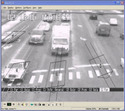Intelligent transportation systems gain ground
Last updated Jul 9, 2010 — 16 views After nearly two decades, intelligent transportation system (ITS) technology is finally gaining ground on our highways, according to a recent article in Better Roads Magazine. While ideas like self-driving vehicles have tickled the fancy of the media and the public, a more immediate goal of ITS is to enable the tracking of vehicle movements in order to manage traffic volume and reduce congestion, the article suggests.
After nearly two decades, intelligent transportation system (ITS) technology is finally gaining ground on our highways, according to a recent article in Better Roads Magazine. While ideas like self-driving vehicles have tickled the fancy of the media and the public, a more immediate goal of ITS is to enable the tracking of vehicle movements in order to manage traffic volume and reduce congestion, the article suggests.
“The promise of ITS is the high-tech transformation of automobile and truck travel, making it faster, safer and more efficient, helping optimize the traffic-carrying capacity of our congested highway infrastructure,” writes Tom Kuennen in the July edition of Better Roads.
A wide range of “meat-and-potatoes” ITS applications “already are transforming how commuters get to work and how traffic is managed throughout American road networks at all levels of government,” according to Kuennen. “And ongoing active research into these relatively low-cost, practical applications of ITS technology means that improvements will continue to flow, and refine how ITS will improve road system utilization.”
He goes on to describe some of the mainstream ITS technologies and how they are being deployed. Examples, according to Kuennen, include “E-Z Pass and ‘open road’ tolling, real-time traffic and transit information, GPS-equipped navigational devices, ‘smart’ traffic signals and parking systems, congestion pricing systems, weigh-in-motion truck inspection, electronic reservation and payment for transportation services, and advanced traffic management systems.”
 Kuennen’s article briefly discusses the U.S. Department of Transportation’s Connected Vehicle Research program area and the current administration’s plans for stepping up ITS investment, which, he says, are aimed at “enhanced funding for ITS for transit and rail, perhaps at the expense of highway users.” Another key motivation behind the administration’s stepped-up ITS interest is the environmental benefit of a more efficient transportation system, he points out.
Kuennen’s article briefly discusses the U.S. Department of Transportation’s Connected Vehicle Research program area and the current administration’s plans for stepping up ITS investment, which, he says, are aimed at “enhanced funding for ITS for transit and rail, perhaps at the expense of highway users.” Another key motivation behind the administration’s stepped-up ITS interest is the environmental benefit of a more efficient transportation system, he points out.
Finally, Kuennen provides an interesting and informative overview of several typical ITS applications, including:
- Dynamic traffic signals, which adjust according to real-time traffic conditions in order to optimize traffic flow
- Dynamic message signs (DMS), which “provide real-time en-route information, including roadway congestion situations, construction activities, incident events, and diversion needs,” plus next-generation Graphic Route Information Panels (GRIPs), which display “instant visualization of congestion ahead”
- Road Weather Information Systems (RWIS) technologies, which increasingly are being integrated into the overall ITS infrastructure
Be sure to read the complete article on the Better Roads Magazine’s website, here.